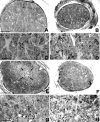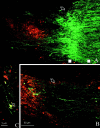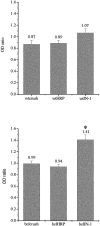Optic nerve crush: axonal responses in wild-type and bcl-2 transgenic mice
- PMID: 10493738
- PMCID: PMC6783029
- DOI: 10.1523/JNEUROSCI.19-19-08367.1999
Optic nerve crush: axonal responses in wild-type and bcl-2 transgenic mice
Abstract
Retinal ganglion cells of transgenic mice overexpressing the anti-apoptotic protein Bcl-2 in neurons show a dramatic increase of survival rate after axotomy. We used this experimental system to test the regenerative potentials of central neurons after reduction of nonpermissive environmental factors. Survival of retinal ganglion cells 1 month after intracranial crush of the optic nerve was found to be 100% in adult bcl-2 mice and 44% in matched wild-type (wt) mice. In the optic nerve, and particularly at the crush site, fibers regrowing spontaneously or simply sprouting were absent in both wt and bcl-2 mice. We attempted to stimulate regeneration implanting in the crushed nerves hybridoma cells secreting antibodies that neutralize central myelin proteins, shown to inhibit regeneration (IN-1 antibodies) (Caroni and Schwab, 1988). Again, we found that regeneration of fibers beyond the site of crush was virtually absent in the optic nerves of both wt and bcl-2 mice. However, in bcl-2 animals treated with IN-1 antibodies, fibers showed sprouting in the proximity of the hybridoma implant. These results suggest that neurons overexpressing bcl-2 are capable of surviving axotomy and sprout when faced with an environment in which inhibition of regeneration has been reduced. Nevertheless, extensive regeneration does not occur, possibly because other factors act by preventing it.
Figures








References
-
- Adams JM, Cory S. The bcl-2 protein family: arbiters of cell survival. Science. 1998;281:1322–1326. - PubMed
-
- Allsopp TE, Wyatt S, Patterson HF, Davies AM. The proto-oncogene bcl-2 can selectively rescue neurotrophic factor-dependent neurons from apoptosis. Cell. 1993;73:295–307. - PubMed
-
- Austyn JM, Gordon S. F4/80, a monoclonal antibody directed specifically against the mouse macrophage. Eur J Immunol. 1981;11:805–815. - PubMed
-
- Bähr M, Przyrembel C, Bastmeyer M. Astrocytes from adult rat optic nerves are nonpermissive for regenerating retinal ganglion cell axons. Exp Neurol. 1995;131:211–220. - PubMed
-
- Bandtlow CE, Schmidt MF, Hassinger TD, Schwab ME, Kater SB. Role of intracellular calcium in NI-35-evoked collapse of neuronal growth cones. Science. 1993;259:80–83. - PubMed
Publication types
MeSH terms
Substances
Grants and funding
LinkOut - more resources
Full Text Sources
Molecular Biology Databases
